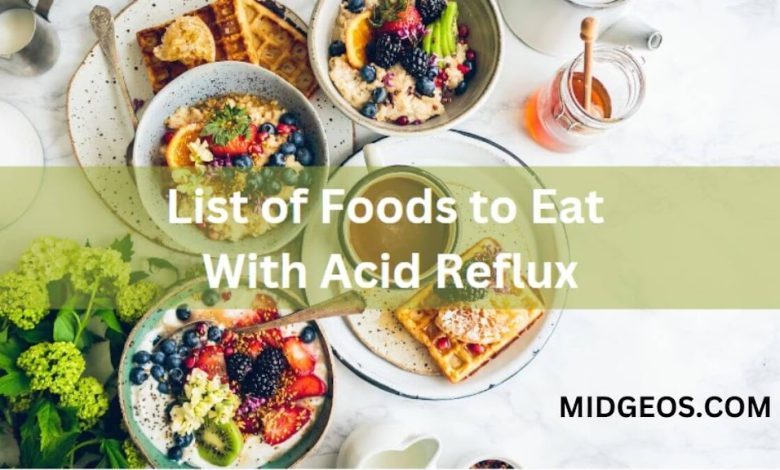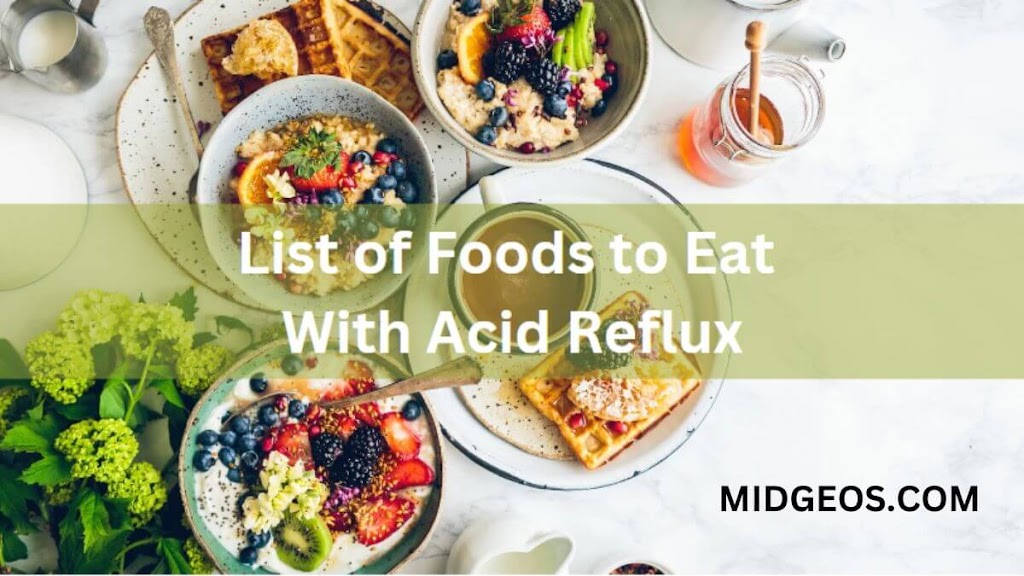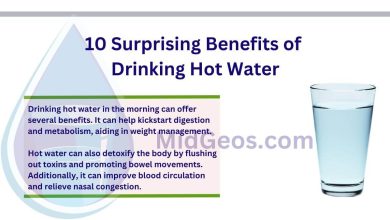List of Foods to Eat With Acid Reflux

Looking for a List of Foods to Eat With Acid Reflux? When stomach acid flows into the esophagus, acid reflux occurs. The majority of GI experts in the area think it might result in heartburn, among other issues. If you have GERD, the following foods should be consumed or avoided.
The use of antacids and PPIs (like Zantac, etc.) decreases stomach acid, which is essentially what causes reflux, claims Chris Kresser.
Low stomach acid encourages the growth of bacteria, which can lead to reflux. By using food to manage your reflux, you can prevent inner pain and physical harm while retaining enough stomach acid to stop bacterial development.
What Aggravates Acid Reflux?
Acid reflux is unpleasant and can cause a hot burning in the chest, a bitter taste in the throat, and gassy bloating in the stomach.
However, what you consume can have an effect. The difference between sweet relief and sour anguish may be determined by the greatest and worst foods for acid reflux.
Acid reflux occurs when the sphincter at the base of the esophagus isn’t working well, allowing fluid from the stomach to enter the esophagus. The worst foods for reflux can worsen painful symptoms, while other foods can soothe them,
List of Foods to Eat With Acid Reflux
– Says UH gastrointestinal surgeon Leena Khaitan, MD
“Diet changes can significantly affect acid reflux and allow you to avoid other treatments,”
– Dr. Khaitan says.
List of Foods to Eat With Acid Reflux
Here is a list of natural foods to eat with acid reflux
Vegetables
- green beans
- broccoli
- asparagus
- cauliflower
- leafy greens
- potatoes
- cucumbers
- Ginger
- Oatmeal
- Chamomile Tea
- Chewing Gum
- Honey and Agave
Non-citrus fruits
- melons
- bananas
- apples
- pears
Lean meats and seafood
- chicken
- turkey
- fish
- seafood
Healthy fats
- avocados
- walnuts
- flaxseed
- olive oil
- sesame oil
- sunflower oil
- Natural Licorice
- Plain Popcorn
- Soups
- Soy Milk
- Tofu
- Vinegar
List of Foods to Eat Avoid With Acid Reflux
The following foods have a high-fat content. Avoid these or eat them sparingly:
- Fatty foods and meals
- French fries
- Onion rings
- Chocolate
- Full-fat dairy products, such as butter, whole milk, regular cheese, and sour cream
- Coffee, tea, and caffeine
- Beer, wine, and alcohol
- Carbonated drinks and sodas
- Fatty or fried cuts of beef, pork, or lamb
- Bacon fat, ham fat, and lard
- Desserts or snacks, such as ice cream and potato chips
- Cream sauces, gravies, and creamy salad dressings
- Oily and greasy foods

- Oranges
- Grapefruit
- Lemons
- Limes
- Pineapple
- Tomato sauce or foods that use it, such as pizza and chili
- Salsa
List of Foods to Eat With Acid Reflux
- গরম পানি খাওয়ার উপকারিতা ও অপকারিতা
- 10 Proven Strategies for Successful Weight Loss
- Ultimate Guide to Rapid Weight Loss: Shedding 10kg in 2 Weeks Without Exercise
- How to Get Rid Belly Fat Quickly: Your Ultimate Guide to Quick and Effective Results
- The 7-Day Fruit Diet: A Delicious Path to Weight Loss
What other lifestyle factors can help alleviate reflux?
- After a meal, go for an hour’s walk.
- Consuming slowly
- Consuming modest or sensible portion amounts
- 3 to 4 hours before going to bed, avoid eating
- Avoiding caffeine and alcohol
- Quit smoking
- Take care when dressing
- Lowering the causes of stress
- Keep a healthy weight
Foods that Neutralize Stomach Acid Immediately
When dealing with acid reflux, it’s essential to know which foods can provide immediate relief by neutralizing stomach acid. These foods can help soothe the irritated esophagus and minimize discomfort. Some examples include:
- Cucumber: Known for its cooling properties, cucumber has a high water content that can help dilute stomach acid.
- Bananas: This fruit is not only a great source of essential vitamins and minerals, but it also contains natural antacids that can neutralize stomach acid.
- Tip: Opt for ripe bananas, as they are easier to digest and gentler on the stomach.
Ten Worst Foods for Acid Reflux
To effectively manage acid reflux, it is crucial to identify and avoid foods that can trigger or worsen symptoms. Here are ten foods commonly associated with acid reflux:
- Citrus fruits: lemons, Oranges, and grapefruits are highly acidic and can irritate the esophagus.
- Tomatoes: Whether in the form of sauce, juice, or raw, tomatoes are known to trigger acid reflux due to their high acidity.
- Spicy Foods: Hot peppers, chili, and spicy sauces can cause a burning sensation and increase stomach acid production.
- Fried and Fatty Foods: Foods high in fat, such as fried foods, can take longer to digest, leading to increased acid production and reflux symptoms.
- Chocolate: Unfortunately, this indulgent treat contains a compound that relaxes the lower esophageal sphincter, allowing stomach acid to flow back up.
- Tip: Opt for dark chocolate with a higher cocoa content, as it tends to have less impact on acid reflux.
- Mint: Although often used to soothe digestive discomfort, mint can relax the lower esophageal sphincter, leading to acid reflux.
- Tip: Opt for herbal teas such as chamomile or ginger instead.
- Coffee and Tea: Both caffeinated and decaffeinated coffee, as well as tea, can trigger acid reflux due to their acidic nature.
- Carbonated Drinks: Beverages like soda and sparkling water can cause bloating and increase pressure on the stomach, leading to acid reflux.
- Onions: Whether cooked or raw, onions can relax the lower esophageal sphincter and worsen symptoms of acid reflux.
- Alcohol: Excessive consumption of alcohol can irritate the stomach lining and increase acid production, leading to acid reflux.
Foods to Avoid with Acid Reflux
In addition to the ten worst foods mentioned above, there are several other food items that individuals with acid reflux should avoid to prevent discomfort and reduce symptoms. These include:
- High-fat Dairy Products: Whole milk, cheese, ice cream, and other high-fat dairy products can trigger acid reflux.
- Processed Meats: Deli meats, sausages, and other processed meats contain additives and preservatives that can aggravate acid reflux.
- High-Fat Snacks: Foods like potato chips, french fries, and other greasy snacks are not only high in fat but are also often seasoned with ingredients that can worsen acid reflux symptoms.
- Sweets and Desserts: Sugary treats, including cakes, cookies, and pastries, can relax the lower esophageal sphincter and contribute to acid reflux.
- Carbonated Beverages: Apart from the aforementioned sodas, carbonated beverages such as sparkling water, energy drinks, and even some flavored water can trigger acid reflux.
15 Foods to Help GERD
Gastroesophageal Reflux Disease (GERD) can cause severe discomfort and requires specific dietary considerations. Incorporating the following 15 foods into your diet may help alleviate symptoms of GERD:
- Oatmeal: A fiber-rich breakfast option that can absorb stomach acid and provide long-lasting satiety.
- Ginger: It has anti-inflammatory properties, ginger can help reduce inflammation in the esophagus.
- Parsley: This herb can aid digestion and provide relief from acid reflux symptoms.
- Fennel: Fennel seeds or bulbs can help soothe the digestive system and help reduce acid reflux symptoms.
- Non-citrus Fruits: Opt for fruits such as melons, apples, and pears, which are less acidic than citrus fruits.
- Leafy Greens: Vegetables like spinach, kale, and Swiss chard are packed with nutrients and fiber, aiding digestion.
- Whole Grains: Foods like brown rice, quinoa, and whole-wheat bread are excellent alternatives to refined grains for individuals with acid reflux.
- Lean Proteins: Chicken breast, turkey, fish, and tofu are lean protein sources that can minimize acid reflux symptoms.
- Almonds: These nuts can provide relief from heartburn by neutralizing stomach acid.
- Aloe Vera: Consuming aloe vera juice may help reduce inflammation and soothe the esophagus.
- Egg Whites: Low in fat and acid, egg whites can be a safe protein option for individuals with acid reflux.
- Low-Fat Yogurt: Opt for plain yogurt or Greek yogurt, which can help maintain a healthy balance of bacteria in the gut.
- Cauliflower: This cruciferous vegetable is low in acid and can be a good addition to an acid reflux-friendly diet.
- Lean Meats: Skinless chicken, turkey, and lean cuts of beef can provide protein without exacerbating acid reflux symptoms.
- Mushrooms: These fungi are a great alternative to high-fat meats and can be used in various dishes for added flavor.
Foods to Help Acid Reflux Go Away
While it’s important to avoid trigger foods, incorporating certain foods into your diet can help acid reflux go away more quickly. The following foods are known for their ability to alleviate symptoms and promote healing:
- Papaya: This tropical fruit contains enzymes that aid digestion and can help reduce inflammation in the esophagus.
- Celery: High in water content, celery can help neutralize stomach acid and protect the delicate esophageal lining.
- Chamomile Tea: Known for its calming properties, chamomile tea can help reduce inflammation and ease discomfort associated with acid reflux.
- Cabbage: Consuming raw or cooked cabbage can help optimize digestion and provide relief from acid reflux symptoms.
- Honey: With its antibacterial properties, honey can help soothe the esophagus and promote healing.
- Whole-Wheat Bread: Opt for whole-wheat bread instead of white bread, as it contains more fiber and is less likely to cause reflux symptoms.
- Watermelon: This hydrating fruit can help neutralize stomach acid and alleviate discomfort.
- Parsnip: This root vegetable is low in acid and can be used as a substitute for higher-acid vegetables in recipes.
- Turmeric: Due to its anti-inflammatory properties, turmeric can help reduce inflammation in the esophagus and ease acid reflux symptoms.
- Barley: High in fiber, barley can promote healthy digestion and reduce the likelihood of acid reflux.
- Cantaloupe: Rich in vitamins and minerals, cantaloupe is a low-acid fruit that can provide relief from acid reflux symptoms.
- Millet: This gluten-free grain is easy to digest and can be a nutritious addition to an acid-reflux-friendly diet.
- Pineapple: Known for its bromelain content, pineapple can aid digestion and alleviate acid reflux symptoms.
- Green Beans: These low-acid vegetables can be included in meals and offer a range of health benefits.
- Lentils: A great source of plant-based protein and fiber, lentils can aid digestion and minimize acid reflux symptoms.
Foods to Help Acid Reflux at Night
Nighttime acid reflux can be particularly uncomfortable, disrupting sleep and causing further irritation. To help alleviate symptoms and promote better sleep, consider adding the following foods to your evening routine:
- Graham Crackers: This light, low-fat snack can help absorb stomach acid and alleviate nighttime acid reflux symptoms.
- Chamomile Tea: Sipping on a warm cup of chamomile tea before bed can have a soothing effect on the stomach and promote better sleep.
- Low-Fat Cheese: Opt for low-fat cheese options like mozzarella or goat cheese, which are less likely to trigger acid reflux symptoms.
- Apple: Consuming a sliced apple before bed can provide relief from acid reflux symptoms and promote better digestion.
- Cottage Cheese: This protein-rich snack can be a good option for those experiencing acid reflux at night.
- Vegetable Soup: A warm bowl of vegetable soup, made with acid-reflux-friendly ingredients, can provide nourishment and promote better digestion.
- Melatonin-Rich Foods: Foods like cherries, bananas, and tomatoes contain melatonin, a hormone that helps regulate sleep and can aid in reducing nighttime acid reflux symptoms.
- Non-Citrus Herbal Infusions: Opt for non-citrus herbal teas like chamomile, ginger, or licorice root, which can help soothe the stomach and reduce acid reflux symptoms.
- Small Portion of Whole Grains: Consuming a small portion of whole grains, like whole-wheat bread or oatmeal, can provide nourishment without triggering acid reflux symptoms.
- Cooked Non-Citrus Fruits: Baking or steaming non-citrus fruits like apples, pears, or peaches can make them easier to digest and less likely to cause acid reflux symptoms.
- 30 Achievable Mental Health Goals to Set in 2025
- List of Foods to Eat With Acid Reflux
- The Healing Elixir: 10 Surprising Benefits of Drinking Hot Water
- The 7-Day Fruit Diet: A Delicious Path to Weight Loss
- How to Get Rid Belly Fat Quickly: Your Ultimate Guide to Quick and Effective Results
What to Drink for Acid Reflux
Choosing the right beverages can make a significant difference in managing acid reflux. While some drinks can exacerbate symptoms, others can help neutralize stomach acid and alleviate discomfort. Consider incorporating the following options into your diet:
- Water: Staying hydrated is crucial for overall health and can help dilute stomach acid.
- Herbal Tea: Opt for herbal teas like chamomile, ginger, or licorice root, which can help soothe the stomach and reduce acid reflux symptoms.
- Aloe Vera Juice: Consuming a small amount of aloe vera juice may help reduce inflammation and soothe the esophagus.
- Almond Milk: A dairy-free alternative, almond milk is low in fat and can help neutralize stomach acid.
- Ginger Ale: Carbonated ginger ale, specifically made with real ginger, can provide relief from acid reflux symptoms.
- Coconut Water: Naturally hydrating and low in acid, coconut water can help minimize discomfort caused by acid reflux.
- Chamomile Tea: Known for its calming properties, chamomile tea can help reduce inflammation and ease discomfort associated with acid reflux.
- Peppermint Tea: While mint itself can trigger acid reflux, peppermint tea made from peppermint leaves can actually provide relief from symptoms due to its soothing properties.
- Licorice Root Tea: Licorice root tea can help reduce inflammation in the esophagus and provide relief from acid reflux symptoms.
- Fresh Fruit Smoothies: Blended with non-citrus fruits, yogurt or almond milk, and a dash of honey, fresh fruit smoothies can be a refreshing and nutritious option for individuals with acid reflux.
2-Week Acid Reflux Diet
Following a strict acid reflux diet for two weeks may lead to a noticeable reduction in symptoms. Consider this sample 2-week acid reflux diet plan:
- Week 1:
- Avoid trigger foods, including citrus fruits, tomatoes, spicy foods, fried and fatty foods, chocolate, mint, coffee and tea, carbonated drinks, onions, and alcohol.
- Incorporate neutralizing foods such as cucumbers and ripe bananas into your daily meals.
- Focus on whole grains, lean proteins, non-citrus fruits, leafy greens, and low-fat dairy products.
- Drink plenty of water and herbal tea.
- Week 2:
- Continue following the dietary guidelines from Week 1.
- Introduce foods known to help alleviate symptoms of GERD, such as ginger, parsley, fennel, and almonds.
- Incorporate additional foods from the previous sections, including papaya, celery, chamomile tea, honey, and millet.
- Monitor your symptoms and make note of any changes or improvements.
The 7-Day Fruit Diet: A Delicious Path to Weight Loss
By sticking to this 2-week acid reflux diet plan, individuals may be able to identify trigger foods, find relief from symptoms, and develop healthier eating habits for long-term management of acid reflux.
Conclusion
Finding the right foods to eat when dealing with acid reflux can be challenging, but it is certainly possible. By understanding which foods can neutralize stomach acid immediately, avoiding trigger foods, incorporating beneficial foods, and following a mindful diet plan, individuals with acid reflux can find relief and improve their overall well-being.
Remember to consult with a healthcare professional or registered dietitian before making any significant dietary changes to ensure they are suitable for your specific needs and health conditions.
It is important to make a doctor’s appointment if you have heartburn or acid reflux that is severe or frequent, Dr. Khaitan adds. Chronic acid reflux is known as gastroesophageal reflux disease (GERD) and can lead to esophageal cancer.
***Disclaimer: The content of this blog does not constitute medical advice or a patient-care provider relationship.


